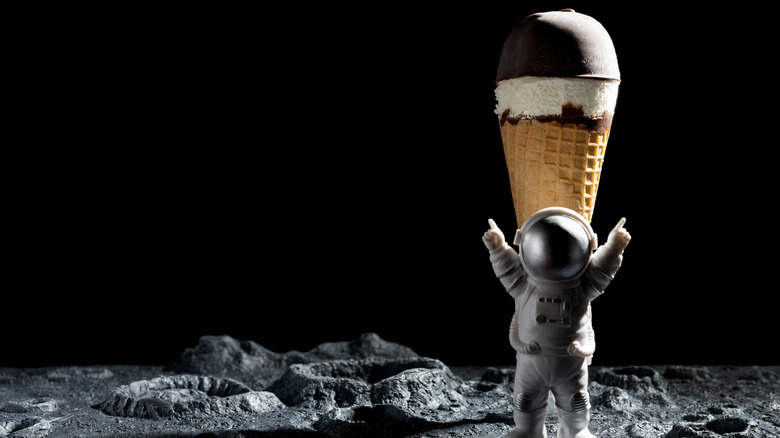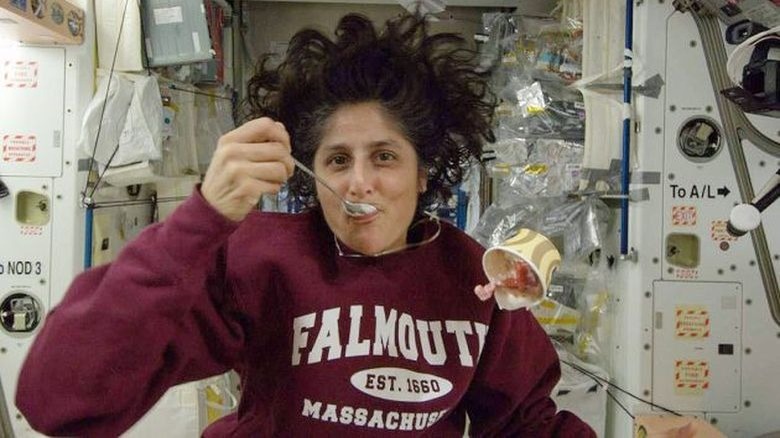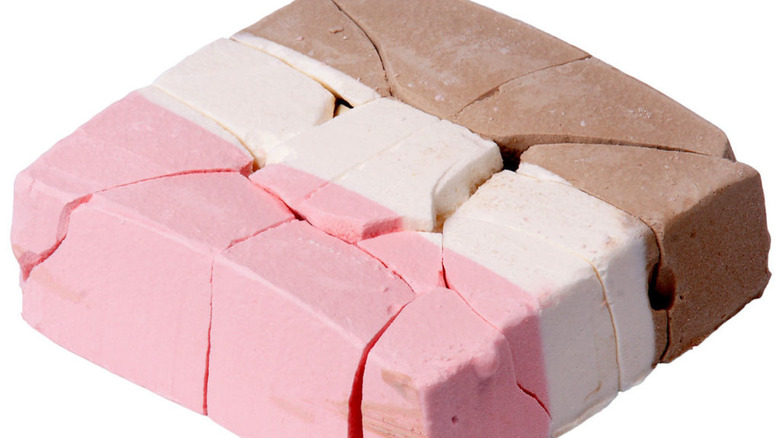The Reason Why Astronauts Can't Have Astronaut Ice Cream In Space
"I scream, you scream, we all scream for ice cream," especially if you're an astronaut. We all know that in space, no one can hear you scream, but even if you did, no astronaut ice cream would be given to you on the final frontier. In 1968, Walter M. Schirra, Donn F. Eisele, and R. Walter Cunningham climbed aboard Apollo 7 and became the first astronauts to crew a mission in NASA's famed Apollo program. It was also the first time freeze-dried Neapolitan ice cream was eaten (out of pouches) in space. It was also the last.
That's not to say ice cream never made it back into space. In 2006 the Space Shuttle Atlantis made a supply run to the International Space Station (ISS). Part of its payload included a new freezer — affectionally called GLACIER — so astronauts could store research samples.
Instead of just sending up an empty freezer, NASA packed it with Blue Bell ice cream cups (vanilla with swirls of chocolate sauce). Six years later, in 2012, more Blue Bell ice cream (chocolate, vanilla, and birthday cake flavors) made it to the ISS aboard a SpaceX Dragon resupply capsule. That was the last time the frozen creamy goodness officially went into space (via National Air and Space Museum).
Astronauts have rarely enjoyed ice cream in space
So if astronauts don't actually eat astronaut ice cream, why is it called "astronaut ice cream?" Good question. As one might imagine, there were many problems to overcome during the early days of NASA, and one of those was figuring out a way to feed its astronauts. Weight is always a concern on space flights, and the tight quarters do not allow for much extra luggage space. Food needed to be light, have a long shelf life, and easily be packaged small while not letting crumbs fly willy-nilly around the environment. Lastly, while having Michelin-star quality wasn't a priority, it had to be easy to prepare and edible.
Freeze-dried food, which offers better nutrition than dehydrated food, has been a staple of NASA's menu from the very start. In fact, the space agency has contributed to the advancement of several different food preservation techniques (dehydration, freeze-drying, intermediate moisture, pasteurization by irradiation, and nitrogen packing) for decades (via NASA). When the public's fascination with space flight took off in the late 1960s and early 1970s, museums worldwide wanted to cash in on the interest and began providing an assortment of space-related souvenirs to sell in their gift shops. The visitor center at the Ames Research Center in California came up with one that still lives in infamy.
Astronaut ice cream is... a gift shop gimmick
In 1973 Ames reached out to American Outdoor Products in Boulder, Colorado. At the time, it was one of the few companies manufacturing and selling freeze-dried food to the public. Ames wanted to know if American Outdoor could make the freeze-dried ice cream in bulk so they could sell it at their gift shop (via NASA).
Owner Ron Smith jumped at the chance but says the first versions of the now-famous treat definitely weren't what everyone has come to know and love. They took frozen solid half-gallon containers of Neapolitan ice cream, cut them with a bandsaw, then freeze-dried it "using a specialized machine, which turned the ice directly into gas" (via Serious Eats). This sublimation process is how tiny air pockets replaced the ice crystals in the ice cream. About three-quarters of that sublimated, freeze-dried ice cream then got stuffed into a pouch.
They finally perfected the process for Ames, but Smith remained convinced it was only a fad. He was wrong. According to The Franklin Institute, "Astronaut Ice Cream" remains one of the most popular souvenirs around the world, selling more than 30,000 packages every year in its Sci Store. And while it's a big hit on planet Earth, astronauts can't eat the brittle product in space because it's prone to break apart and get crumbs in all the wrong places. Precisely the same reason bread isn't allowed in space.


